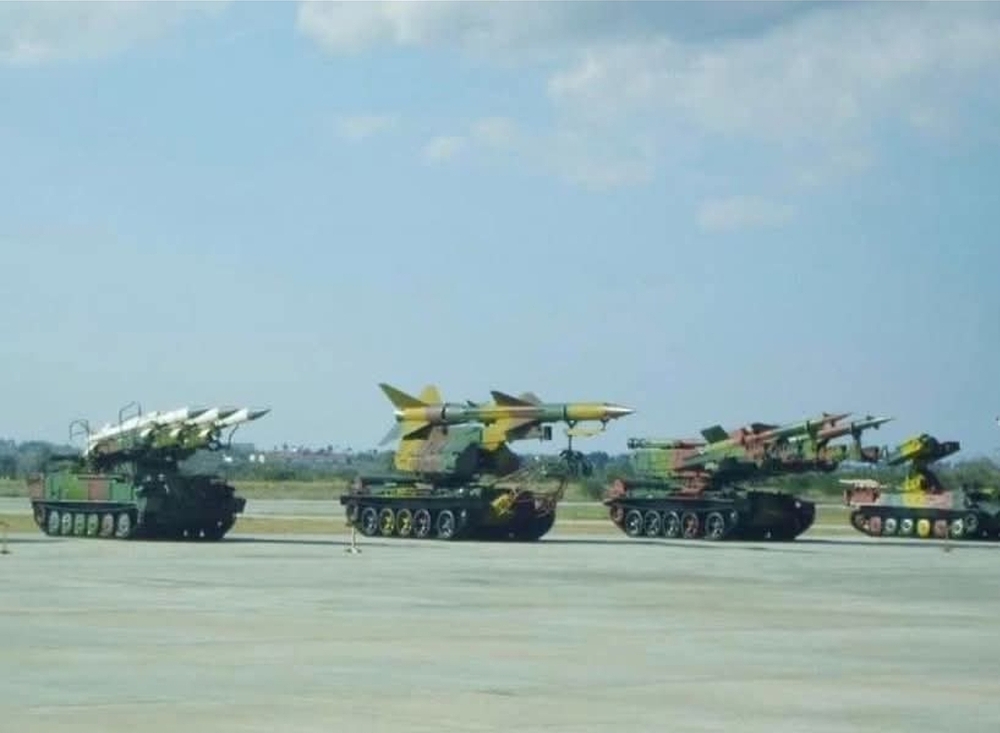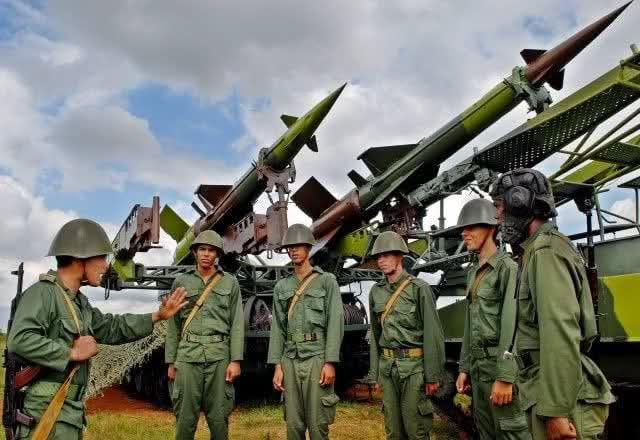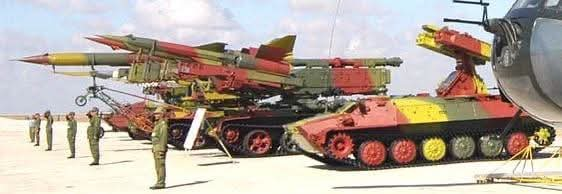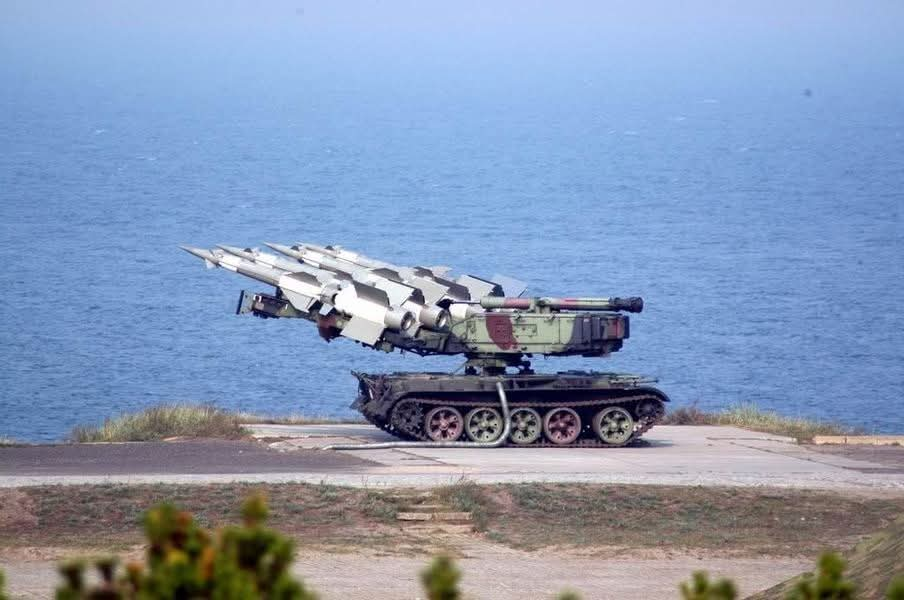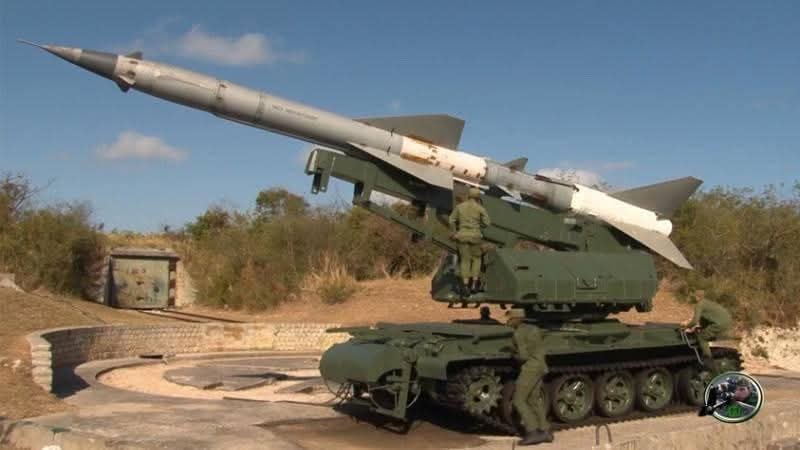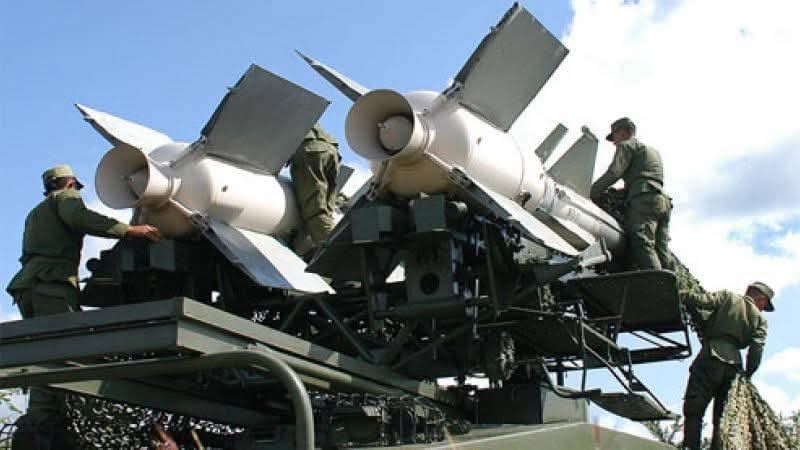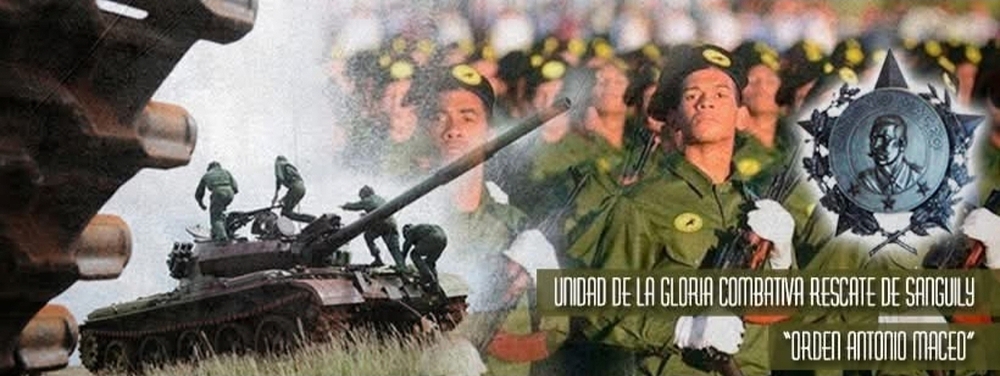Would you like to see the Volkhov in the game?
Where would you like to see it in-game?
- In the Soviet Tree
- In the Cuban Tree
- In an Alternative Tree
- No, I don’t want to see this in-game
S-75M3 “Volkhov” on a T-55 Chassis
The Arab-Israeli Wars of the 1960s and 70s made it clear that in a modern conflict against a technologically advanced adversary, static SAM positions rarely survived long after firing, regardless of how effective their initial volley may have been. Cuba is likely the only nation known to have developed a mobile version of the S-75M3 surface-to-air missile system, mounting key components onto tracked armored chassis, based on the T-55 tank hull. This adaptation appears to have been a locally engineered solution to improve the survivability and flexibility of the otherwise static missile platform.
The S-75M3 “Volkhov” represented the final evolution of the Soviet S-75 family of surface-to-air missile systems, culminating decades of refinement since the original system’s introduction in the late 1950s. Introduced in the mid-1970s, the M3 retained the general structure and layout of its predecessors, but featured improved electronics, radar integration, and missile compatibility, particularly with the V-759 (5Ya23) missile, a modernized, low-to-high altitude interceptor.
This upgraded Cuban S-75M3 mounted on a T-55 chassis may be the most logical way to introduce the iconic S-75 system into War Thunder. By combining a historically accurate Cold War modification with mobility and gameplay viability, it offers a grounded approach to representing one of the most feared SAM systems of the 20th century.
History and Development
Spoiler
The S-75 was developed by the Soviet Union in the early 1950s to provide a defense against high-altitude, high-speed threats, primarily American strategic bombers like the B-47 and B-52, which conventional anti-aircraft artillery could no longer reach effectively. It was conceived as a radar-guided surface-to-air missile system capable of destroying aircraft at extreme ranges and altitudes. However, the earliest variants had a significant limitation: a minimum engagement altitude of around 3,000 meters. This created a dangerous gap in coverage, leaving the system highly vulnerable to low-flying jets and strike aircraft. In response, every subsequent upgrade to the S-75 family focused on closing this gap. Through improvements in radar tracking, guidance software, and missile handling, the minimum engagement altitude was progressively reduced, culminating in the S-75M3, which was reportedly capable of intercepting targets flying as low as 100 meters.
In its early form, the S-75 system proved largely ineffective against low-flying targets, which could exploit terrain masking and the radar’s minimum engagement altitude. However, with the introduction of upgraded variants and improved radar support, the system’s effectiveness increased significantly. During the War of Attrition and the 1973 Yom Kippur War, these enhancements allowed S-75 batteries to achieve a substantial number of confirmed kills against Israeli aircraft, marking a turning point in their operational value.
The S-75M3 built directly on the improvements introduced with the earlier S-75M2 variant, which first brought the V-759 missile into operational use. While the M2 marked a leap forward in range and countermeasure resistance, the M3 aimed to make the system more survivable, more accurate, and more resistant to electronic jamming, particularly in the face of NATO’s rapidly advancing electronic warfare capabilities.
The V-759 missile, known internally as the 5Ya23, was a two-stage weapon. It consisted of a solid-fuel booster paired with a liquid-fueled sustainer, powered by storable propellants. The missile measured just under 11 meters in length and weighed approximately 2.4 tons at launch. It carried a high-explosive fragmentation warhead weighing nearly 200 kilograms, capable of destroying aircraft with a single well-placed hit. Its effective engagement envelope stretched from extremely altitudes all the way to near-space flight corridors, with a vertical reach of over 30 kilometers and a slant range exceeding 55 kilometers.
In the S-75M3, the V-759 was used alongside upgraded command and guidance systems. While the missile itself remained largely the same as the one used in the M2 variant, its targeting precision and response to countermeasures were significantly improved thanks to new radar interfaces and more stable guidance signals.
Guidance Radar
Spoiler
The fire-control radar used with the S-75M3 was an enhanced version of the SNR-75 “Fan Song” series or “Fan Song F” or a further sub-variant depending on local nomenclature. This radar operated in the C/E band and featured twin tracking antennas for azimuth and elevation. The system included electro-optical sights and a television camera housed in a dedicated cabin above the main radar unit, giving operators the ability to continue engaging targets even under heavy jamming conditions. Optical tracking also allowed for silent target acquisition in some cases, minimizing electronic signature. The Fan Song radar tracked both the missile and the target simultaneously, issuing course correction commands via radio uplink. In later versions, the system could automatically switch to “home-on-jam” modes or switch to optical guidance if radar lock was lost. These capabilities made the M3 far more resilient in environments with advanced ECM.
The Fan Song radar was so feared by Israeli pilots during the 1973 war that simply switching it into guidance or launch mode, without firing a single missile, was often enough to trigger preemptive evasive maneuvers or force aircraft to retreat and jettison their ordnance. In some cases, the psychological impact of the radar alone secured tactical victories without a single launch.
Supporting Radar Infrastructure
Spoiler
In addition to the fire-control radar, S-75M3 sites relied on a suite of supporting radars. Primary long-range search was typically handled by systems like the P-12 “Spoon Rest”, a VHF radar capable of detecting high-altitude aircraft at several hundred kilometers. Secondary surveillance often came from the P-15 “Flat Face” radar, operating in the UHF range and providing faster updates and better tracking for low-altitude targets. For altitude data, the PRV-11 “Side Net” height-finder radar was employed, giving precise vertical information to the targeting solution. Combined, this radar network allowed S-75M3 batteries to detect, track, and engage high-speed, high-altitude targets over vast distances. The system could queue and coordinate multiple launches from dispersed launchers using centralized tracking data, making it difficult for adversaries to eliminate a battery with a single strike.
Deployment and Service
Spoiler
In the Cuban context, the S-75M3 “Volkhov” was received as part of the island’s deep military ties with the Soviet Union during the Cold War. While originally developed for the USSR’s air defense network, this advanced variant was exported to key allies like Cuba, where it became a cornerstone of long-range air defense. The system offered a broader engagement envelope than earlier models and incorporated upgrades that improved its performance against a wider range of threats, including low-flying or jamming-equipped aircraft. The M3’s integration of analog fire-control computers, optical tracking capabilities, and improved resistance to electronic countermeasures made it especially valuable in Cuba’s layered defense network. Its use of the V-759 missile, with enhanced range and altitude performance, marked it as the most capable version of the S-75 family deployed on the island.
However, this mobile adaptation of the S-75M3 introduces several practical concerns. One of the most immediate issues is the missile reload process. Standard reloading vehicles were designed to service ground-level launchers, but the tracked chassis used in the Cuban version raises the missile rail significantly, likely placing it out of reach for conventional reload equipment. This could result in much longer reload times, or even require specially adapted loading methods, compared to the static version.
Moreover, the S-75’s missile uses hypergolic liquid propellants, including highly toxic and corrosive substances such as nitric acid-based oxidizers. These demand strict handling procedures, constant monitoring, and well-ventilated conditions. Mounting such a missile on a fully mobile, armored chassis, particularly one based on the relatively stiff and rugged T-55, raises serious safety concerns. Harsh terrain, vibration, or excessive off-road maneuvering could compromise the missile’s structural integrity, posing a significant hazard to the crew and support personnel.
Despite the availability of far more modern air defense systems by the 1980s, Cuba continued to rely on its S-75M3 “Volkhov” batteries well into the late Cold War and beyond. This persistence was largely driven by economic constraints and international sanctions, which limited access to newer missile technology. In an effort to extend the operational relevance of these aging systems and adapt to the demands of modern warfare, Cuban engineers mounted the S-75 launchers on T-55 tank chassis. While this solution did not eliminate the system’s inherent limitations, it offered increased mobility and improved survivability, critical factors for a country forced to make the most of its legacy equipment.
Cuban S-75M3 “Volkhov” on T-55 Chassis — Specifications
Spoiler
Vehicle Type:
Mobile strategic surface-to-air missile launcher (SAM)
Origin:
Republic of Cuba (converted from Soviet hardware)
Based On:
- Missile system: S-75M3 “Volkhov” (SA-2 Guideline Mod 5)
- Chassis: Soviet T-55 medium tank (hull only, turret removed)
Dimensions (approximate):
- Length (with missile): ~11.5–12.0 meters
- Hull length: ~6.2 meters (T-55 base)
- Width: ~3.27 meters
- Height (erected missile): ~11.0 meters
- Height (travel mode): ~3.3–3.5 meters
- Ground clearance: ~0.43 meters
Weight:
- Chassis (T-55, turretless): ~27.0–28.0 metric tons
- Launch assembly & mounted V-759 missile: ~2.5–3.0 metric tons
- Total estimated weight (combat loaded): ~30.0–31.5 metric tons
Crew:
~1–3
Mobility:
- Engine: V-55 12-cylinder diesel (T-55 standard)
- Horsepower: 580 hp
- Transmission: 5-speed manual
- Power-to-weight ratio: ~18.5–19.3 hp/ton (estimated)
- Top road speed: 45–50 km/h
- Operational range: ~450 km on road
- Suspension: Torsion bar
- Mobility Limitations: Not intended for high-speed or extreme off-road maneuvering due to missile stability and fuel handling risks.
Armament:
Primary Armament:
- Missile: V-759 (5Ya23)
- Missile length: 10.6 meters
- Weight: 2,406 kg
- Warhead: 195 kg high-explosive fragmentation
- Warhead lethality radius: ~65–75 meters
- Maximum Elevation: 85 degrees from horizontal
- Propulsion: Two-stage (solid-fuel booster + liquid-fuel sustainer)
- Propellants: AK-27I (oxidizer) + TG-02 (fuel) – hypergolic, highly toxic
Missile Performance:
- Range: ~6 km (minimum) to ~55–60 km (maximum)
- Altitude envelope: 100 m – 30,000 m
- Max target speed: ~3,700 km/h
- Guidance: Command-guided via radar (no onboard seeker)
Hit Probability
| Target Type |
(1 Missile) |
(2 Missile Salvo) |
| High-altitude bomber (e.g., B-52, Tu-95) |
0.75 – 0.90 |
0.95+ |
| Tactical fighter (non-maneuvering) |
0.45 – 0.65 |
0.75 – 0.85 |
| Fighter, maneuvering & jamming |
0.20 – 0.40 |
0.50 – 0.70 |
| Low-flying fast jets |
0.10 – 0.30 |
0.30 – 0.50 |
Fire Control & Radar Integration:
This mobile launcher relies on external radar systems for targeting and launch solutions:
- Guidance Radar: RSN-75V “Fan Song F” or equivalent
- Radar tracks both missile and target
- Allows command guidance corrections
- Features optical backup, home-on-jam capability, and TV camera
| Attribute |
Value |
| Crew |
3–4 onboard (additional in support vehicles) |
| Estimated Weight |
~31–32 metric tons |
| Engine |
V-55, 12-cylinder diesel, 580 hp |
| Power-to-Weight |
~18.1–18.7 hp/ton |
| Top Speed |
~45–50 km/h (on road) |
| Detection Range |
~65–70 km (effective for medium-sized aircraft) |
| Minimum Detection Range |
~6–8 km (target tracking threshold) |
| Altitude Coverage |
~100 m (minimum) to ~27,000–30,000 m (max) |
| Maximum Target Speed |
~3,500–4,000 km/h (depending on closure rate and radar lock quality) |
- Search Radar (typically towed or fixed nearby):
- P-12 “Spoon Rest” – early warning radar
| Parameter |
Value |
| Frequency band |
VHF (A-band): ~150–170 MHz |
| Pulse repetition freq. |
~300–600 pulses/sec |
| Pulse width |
~2.5 to 12 μs (adjustable) |
| Peak power output |
~300 kW |
| Detection range |
Up to 275–300 km (for high-altitude targets) |
| Minimum detection range |
~6–10 km |
| Target resolution |
~2–3 km in range; poor angular resolution |
| Azimuth coverage |
360° (rotating) |
| Altitude determination |
None (requires separate height-finder, e.g., PRV-11) |
Reloading & Logistics Challenges:
- Reload time: Likely extended compared to fixed S-75 due to launcher height and lack of purpose-built reloading vehicle compatibility
Protection:
- Hull armor (T-55):
- Upper glacis: 100 mm (inclined)
- Sides: ~80 mm
- Rear: 45 mm
- Launcher mount: Unarmored – no protection for missile or equipment
Core Components of an S-75 Battery:
- Missile Launchers:
- 6 SM-90 launchers, each with one ready-to-fire missile.
- Arranged in a circular or semi-circular layout around the central guidance radar.
- Missiles:
- V-750 / V-759 / V-760 series missiles, depending on the variant.
- Typically one missile per launcher, with several reloads per launcher stored nearby.
- Fire-Control Radar (Guidance):
- RSN-75 “Fan Song” radar (various subtypes: A to F).
- Tracks both the missile and target, sending course correction commands.
- May include optical or TV tracking as a backup in later variants.
- Acquisition/Surveillance Radars:
- P-12 “Spoon Rest” – early warning and target acquisition radar (VHF band).
- P-15 “Flat Face” – backup or low-altitude target radar (UHF band).
- PRV-11 “Side Net” – height-finder radar (E-band), used to determine target altitude.
- Missile Transport and Reload Vehicles:
- Specialized transloader trucks (e.g., SM-61) for moving and erecting missiles.
- Fuel trucks for handling toxic liquid propellants (AK-27 oxidizer and TG-02 fuel).
- Warhead transport and maintenance vehicles.
- Power Supply Units:
- Mobile diesel generators or power trucks to support the radars and command systems.
- Command and Control:
- Battery command post (PU or UNK vehicle), which relayed orders from regimental HQ.
- Field telephones and cable reels to connect all radar and launcher positions.
- Crew:
- Roughly 75 to 100 personnel per battery, including radar operators, missile technicians, guards, and drivers.
Videos
Sources
View
Service and combat use of later modifications of the S-75 air defense system delivered to other countries and their foreign clones
The Oryx Handbook Of Cuban Fighting Vehicles - Oryx
SA-2
ЗРК С-75 (Иркутск): myauu — LiveJournal
S-75 Dvina - Wikipedia











